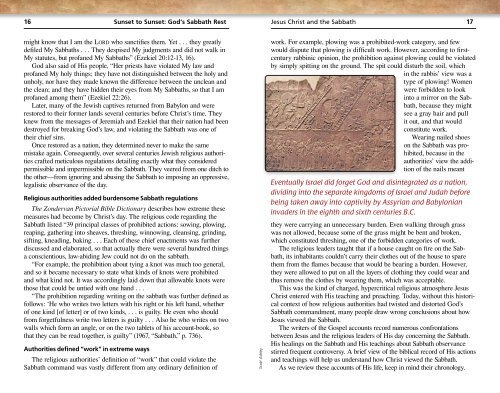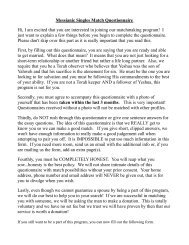Sunset to Sunset: God's Sabbath Rest - Messianic Singles Home
Sunset to Sunset: God's Sabbath Rest - Messianic Singles Home
Sunset to Sunset: God's Sabbath Rest - Messianic Singles Home
Create successful ePaper yourself
Turn your PDF publications into a flip-book with our unique Google optimized e-Paper software.
16 <strong>Sunset</strong> <strong>to</strong> <strong>Sunset</strong>: God’s <strong>Sabbath</strong> <strong>Rest</strong> Jesus Christ and the <strong>Sabbath</strong><br />
17<br />
might know that I am the Lor d who sanctifies them. Yet . . . they greatly<br />
defiled My <strong>Sabbath</strong>s . . . They despised My judgments and did not walk in<br />
My statutes, but profaned My <strong>Sabbath</strong>s” (Ezekiel 20:12-13, 16).<br />
God also said of His people, “Her priests have violated My law and<br />
profaned My holy things; they have not distinguished between the holy and<br />
unholy, nor have they made known the difference between the unclean and<br />
the clean; and they have hidden their eyes from My <strong>Sabbath</strong>s, so that I am<br />
profaned among them” (Ezekiel 22:26).<br />
Later, many of the Jewish captives returned from Babylon and were<br />
res<strong>to</strong>red <strong>to</strong> their former lands several centuries before Christ’s time. They<br />
knew from the messages of Jeremiah and Ezekiel that their nation had been<br />
destroyed for breaking God’s law, and violating the <strong>Sabbath</strong> was one of<br />
their chief sins.<br />
Once res<strong>to</strong>red as a nation, they determined never <strong>to</strong> make the same<br />
mistake again. Consequently, over several centuries Jewish religious authorities<br />
crafted meticulous regulations detailing exactly what they considered<br />
permissible and impermissible on the <strong>Sabbath</strong>. They veered from one ditch <strong>to</strong><br />
the other—from ignoring and abusing the <strong>Sabbath</strong> <strong>to</strong> imposing an oppressive,<br />
legalistic observance of the day.<br />
Religious authorities added burdensome <strong>Sabbath</strong> regulations<br />
The Zondervan Pic<strong>to</strong>rial Bible Dictionary describes how extreme these<br />
measures had become by Christ’s day. The religious code regarding the<br />
<strong>Sabbath</strong> listed “39 principal classes of prohibited actions: sowing, plowing,<br />
reaping, gathering in<strong>to</strong> sheaves, threshing, winnowing, cleansing, grinding,<br />
sifting, kneading, baking . . . Each of these chief enactments was further<br />
discussed and elaborated, so that actually there were several hundred things<br />
a conscientious, law-abiding Jew could not do on the sabbath.<br />
“For example, the prohibition about tying a knot was much <strong>to</strong>o general,<br />
and so it became necessary <strong>to</strong> state what kinds of knots were prohibited<br />
and what kind not. It was accordingly laid down that allowable knots were<br />
those that could be untied with one hand . . .<br />
“The prohibition regarding writing on the sabbath was further defined as<br />
follows: ‘He who writes two letters with his right or his left hand, whether<br />
of one kind [of letter] or of two kinds, . . . is guilty. He even who should<br />
from forgetfulness write two letters is guilty . . . Also he who writes on two<br />
walls which form an angle, or on the two tablets of his account-book, so<br />
that they can be read <strong>to</strong>gether, is guilty” (1967, “<strong>Sabbath</strong>,” p. 736).<br />
Authorities defined “work” in extreme ways<br />
The religious authorities’ definition of “work” that could violate the<br />
<strong>Sabbath</strong> command was vastly different from any ordinary definition of<br />
Scott Ashley<br />
work. For example, plowing was a prohibited-work category, and few<br />
would dispute that plowing is difficult work. However, according <strong>to</strong> firstcentury<br />
rabbinic opinion, the prohibition against plowing could be violated<br />
by simply spitting on the ground. The spit could disturb the soil, which<br />
in the rabbis’ view was a<br />
type of plowing! Women<br />
were forbidden <strong>to</strong> look<br />
in<strong>to</strong> a mirror on the <strong>Sabbath</strong>,<br />
because they might<br />
see a gray hair and pull<br />
it out, and that would<br />
constitute work.<br />
Wearing nailed shoes<br />
on the <strong>Sabbath</strong> was prohibited,<br />
because in the<br />
authorities’ view the addition<br />
of the nails meant<br />
Eventually Israel did forget God and disintegrated as a nation,<br />
dividing in<strong>to</strong> the separate kingdoms of Israel and Judah before<br />
being taken away in<strong>to</strong> captivity by Assyrian and Babylonian<br />
invaders in the eighth and sixth centuries B.C.<br />
they were carrying an unnecessary burden. Even walking through grass<br />
was not allowed, because some of the grass might be bent and broken,<br />
which constituted threshing, one of the forbidden categories of work.<br />
The religious leaders taught that if a house caught on fire on the <strong>Sabbath</strong>,<br />
its inhabitants couldn’t carry their clothes out of the house <strong>to</strong> spare<br />
them from the flames because that would be bearing a burden. However,<br />
they were allowed <strong>to</strong> put on all the layers of clothing they could wear and<br />
thus remove the clothes by wearing them, which was acceptable.<br />
This was the kind of charged, hypercritical religious atmosphere Jesus<br />
Christ entered with His teaching and preaching. Today, without this his<strong>to</strong>rical<br />
context of how religious authorities had twisted and dis<strong>to</strong>rted God’s<br />
<strong>Sabbath</strong> commandment, many people draw wrong conclusions about how<br />
Jesus viewed the <strong>Sabbath</strong>.<br />
The writers of the Gospel accounts record numerous confrontations<br />
between Jesus and the religious leaders of His day concerning the <strong>Sabbath</strong>.<br />
His healings on the <strong>Sabbath</strong> and His teachings about <strong>Sabbath</strong> observance<br />
stirred frequent controversy. A brief view of the biblical record of His actions<br />
and teachings will help us understand how Christ viewed the <strong>Sabbath</strong>.<br />
As we review these accounts of His life, keep in mind their chronology.



